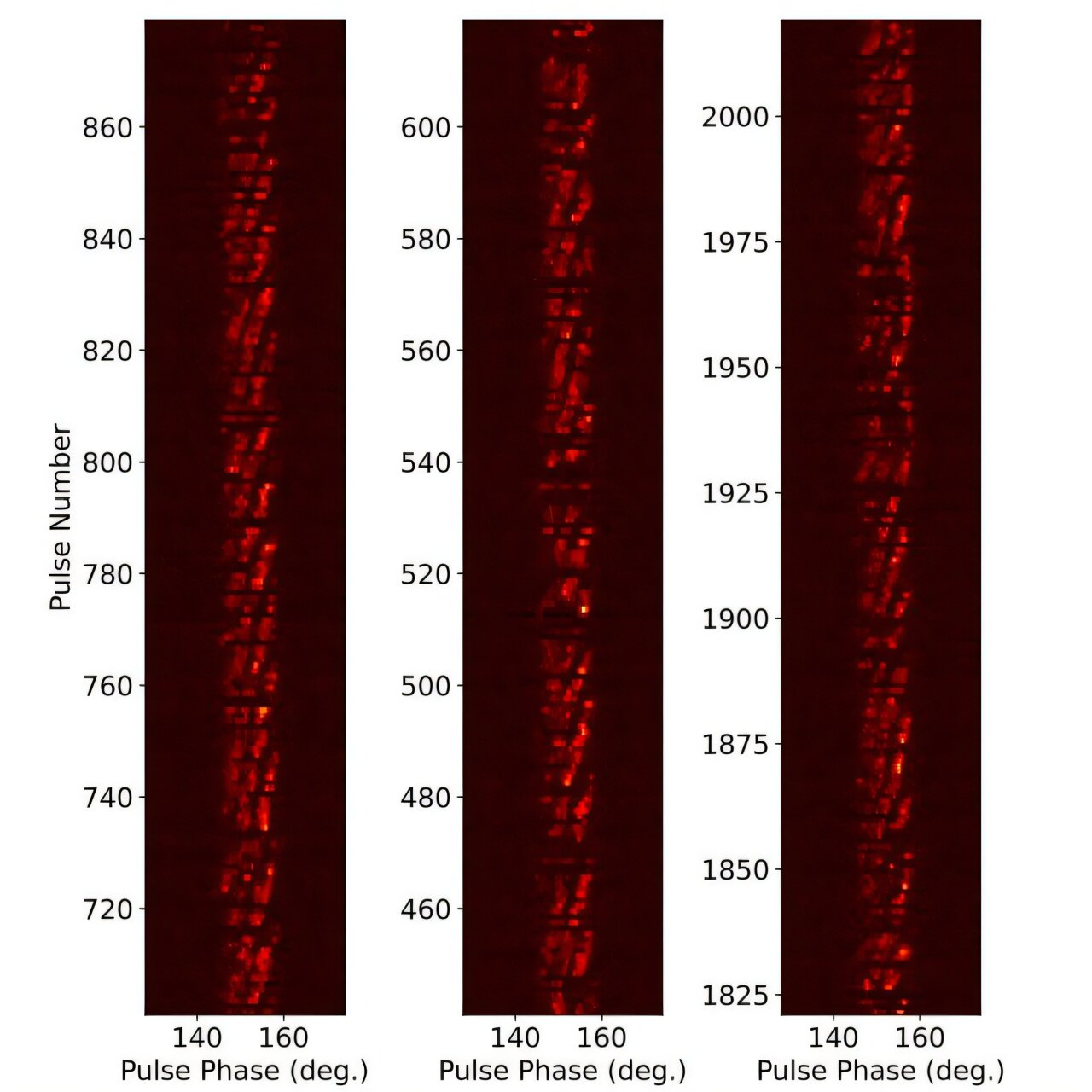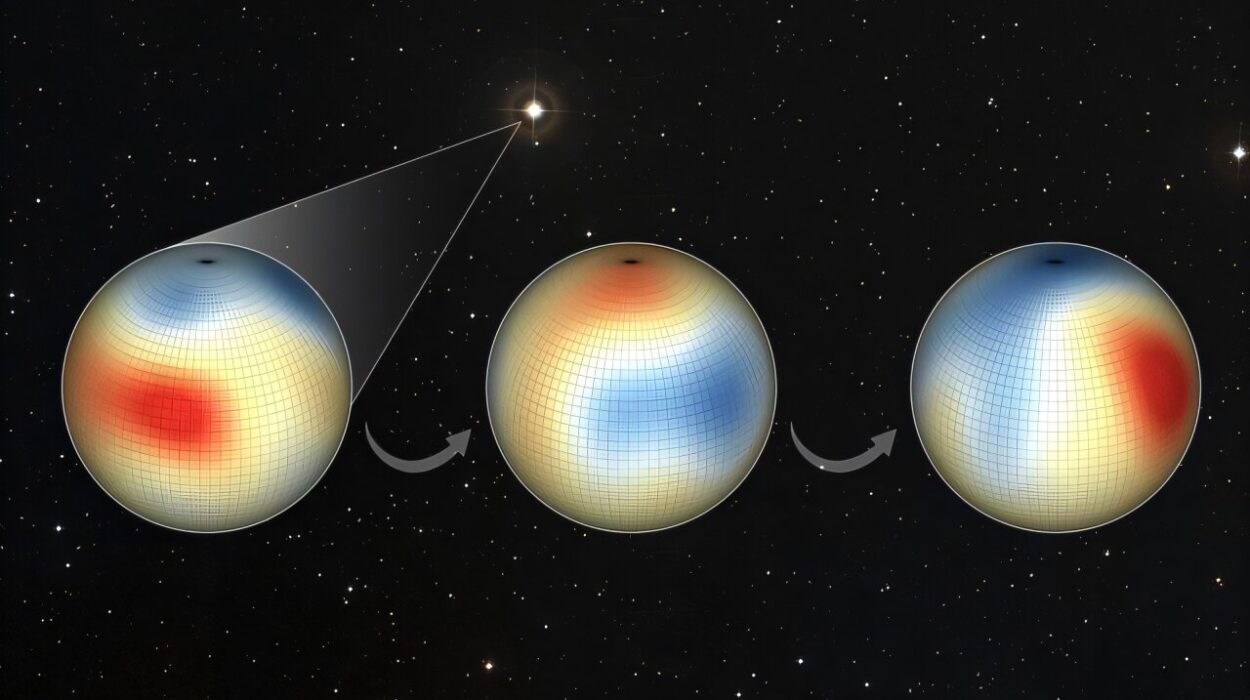Far beyond the shimmering arms of our Milky Way, roughly 7,500 light-years from Earth, there spins a faint but steadfast cosmic lighthouse—a pulsar known as PSR J2129+4119. To the untrained eye, it’s just another distant point of radio light among billions. But to astronomers, it’s a living chronicle of physics, energy, and mystery.
Using the Five-hundred-meter Aperture Spherical Radio Telescope (FAST)—the largest and most sensitive single-dish radio telescope on Earth—a team of astronomers from the Chinese Academy of Sciences (CAS) has recently turned their gaze toward this quiet, aging star. What they discovered wasn’t the slow fade of a dying beacon, but a pulsar stubbornly refusing to go dark—its signals pulsing with complexity, rhythm, and resilience that defy expectations.
Their findings, published in late October 2025 on the arXiv preprint server, offer not just a scientific breakthrough, but a poetic glimpse into how even an “old” star can surprise us with new life.
A Star That Should Have Gone Silent
To understand the wonder of PSR J2129+4119, one must first understand what it is. Pulsars are the remnants of once-massive stars—dense, rapidly spinning neutron stars that emit beams of radio waves from their magnetic poles. As they rotate, these beams sweep across space like cosmic lighthouses, reaching Earth as regular, precise pulses.
But PSR J2129+4119 is no ordinary pulsar. Discovered in 2017, it is ancient by cosmic standards—around 342.8 million years old. Its rotation period is slow, completing one spin every 1.69 seconds. For comparison, some younger pulsars spin hundreds of times per second. By all accounts, PSR J2129+4119 should be fading—teetering near the so-called “death line,” a theoretical boundary beyond which pulsars lose their ability to emit coherent radio waves.
And yet, against expectation, this one still speaks.
FAST: The Ear That Hears the Universe
Enter FAST, the world’s most sensitive radio telescope nestled within the lush mountains of Guizhou, China. Its colossal dish—spanning half a kilometer across—acts like an ear pressed to the universe’s heartbeat. With its extraordinary sensitivity, FAST can detect even the faintest whispers of radio energy from across the galaxy.
Led by astronomer Habtamu Menberu Tedila and his team at CAS, researchers trained FAST on PSR J2129+4119 to study its behavior in exquisite detail. What they found transformed a quiet data point into a cosmic drama of persistence and complexity.
The Many Voices of a Single Star
The FAST observations revealed that PSR J2129+4119 doesn’t emit radio signals in just one way—it speaks in multiple modes, switching between patterns of silence and sound with a rhythm that feels almost alive.
The pulsar exhibits three primary emission states: nulls, weak pulses, and regular pulses, occasionally punctuated by sudden bright flashes. During nulls, the pulsar falls silent—its emission ceases entirely for a few seconds or even minutes. Then, without warning, it reignites, sending out weak pulses before returning to its steady, rhythmic beat.
What makes this remarkable is that PSR J2129+4119 lies below the death line—meaning, theoretically, it shouldn’t be able to emit coherent radio waves at all. Yet it does, and not only that—it does so with personality.
The team found that the pulsar’s nulling fraction—the percentage of time it spends in silence—is about 8.13%. In other words, this ancient star spends over 90% of its time still emitting, against all odds.
The Dance of Polarization and Precision
Another fascinating feature of PSR J2129+4119 is its polarization—a measure of how its light waves align as they travel through space. Both the regular and weak pulses show high linear polarization, indicating a well-ordered magnetic field structure within the pulsar’s magnetosphere.
The data also revealed that our line of sight to the pulsar passes close to its magnetic edge, with an impact angle of about -3 degrees. This nearly tangential perspective allows astronomers to study subtle details of how its beams sweep across the cosmos, like tracing the edges of a lighthouse beam from afar.
Even more intriguing, after each nulling phase, the pulsar’s regular pulses exhibit enhanced trailing components—the tail end of the signal grows stronger compared to before the null. This pattern hints at magnetospheric reactivation—a gradual rebuilding of the pulsar’s internal magnetic environment rather than a simple geometric effect.
In essence, PSR J2129+4119 doesn’t merely turn on and off—it recovers, reorganizes, and resumes, as though rebooting its stellar heartbeat.
The Subtle Music of Microstructure
When astronomers zoomed in even closer, FAST uncovered something exquisite within the pulsar’s steady rhythm: microstructure—tiny, fleeting fluctuations within each radio pulse, occurring on millisecond timescales.
In about 64% of the regular pulses, researchers detected quasi-periodic microstructure with a mean periodicity of 4.57 milliseconds and a mean width of 4.3 milliseconds. These subtle variations are like microbeats within the pulsar’s main rhythm—short bursts of energy that reveal the fine structure of its emission process.
Understanding these patterns helps scientists probe the inner workings of the pulsar’s magnetosphere, where electric and magnetic fields interact with charged particles in ways we still don’t fully comprehend.
A Star on the Edge of Emission
Taken together, these observations paint a picture of a pulsar operating at the edge of survival—its magnetic engine sputtering but still managing to shine. The variety of emission behaviors, from beat-like modulation to quasi-periodic microstructure, suggests that PSR J2129+4119’s magnetosphere operates near the threshold for coherent emission.
This means its internal plasma processes—responsible for generating radio waves—are just barely able to sustain themselves. Like an old musician playing his final symphony, the pulsar’s signals carry both fragility and grace, offering astronomers a rare glimpse into what happens as stars approach the limits of their radio lives.
Why It Matters
You might wonder—why study a single, faint pulsar? Because in astronomy, even one voice can rewrite the symphony.
Pulsars like PSR J2129+4119 serve as natural laboratories for extreme physics. They help scientists test theories of magnetism, particle acceleration, and general relativity under conditions that can’t be replicated on Earth. Studying pulsars near the death line provides crucial insight into how radio emission ceases, and what physical processes allow some stars to defy the end.
Moreover, such observations refine our understanding of neutron star evolution, helping astronomers map how these remnants age, cool, and transform over millions of years.
The Human Connection to a Cosmic Pulse
Beyond the equations and data lies something profoundly human—a connection to the cosmos that transcends time and distance. When FAST detects a pulse from PSR J2129+4119, it is capturing a signal that began its journey before human civilization even dreamed of technology. Each beat is a memory of a star that died long ago, transformed into something both ghostly and enduring.
There’s a quiet poetry in that: a dead star that still sings, a relic that still whispers across the cosmic ocean, and humans—tiny and fragile—who have built machines sensitive enough to listen.
The Future of Listening
The discovery of PSR J2129+4119’s surprising vitality marks only the beginning. As FAST continues to scan the heavens, it will likely uncover more pulsars that challenge our understanding of how radio emission works. With its unprecedented sensitivity, FAST allows astronomers to observe single pulses with breathtaking clarity—each one a thread in the larger fabric of stellar evolution.
Future studies will aim to model how magnetospheres behave near the emission threshold, shedding light on how and why some pulsars continue to pulse while others fall silent. In doing so, we inch closer to answering one of astrophysics’ most haunting questions: when does a pulsar truly die?
More information: Habtamu Menberu Tedila et al, Multi-Faceted Emission Properties of PSR J2129+4119 Observed with FAST, arXiv (2025). DOI: 10.48550/arxiv.2510.26209






